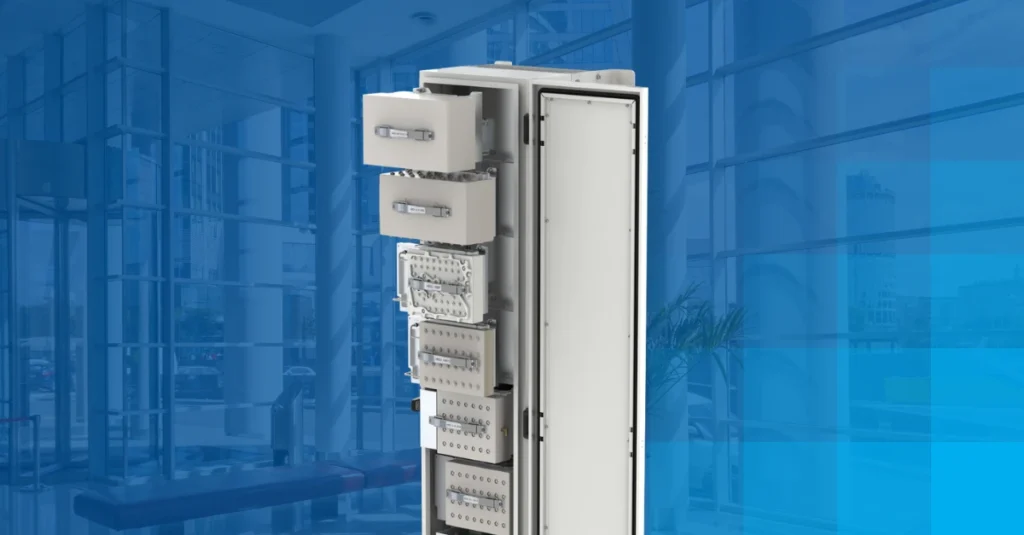Since the advent of mobile communications, the telecoms industry has witnessed immense transformation and technological evolution. From basic voice calls to lightning-fast 5G data, each new mobile generation ushers in advancements in features, speed, and capacity. However, keeping up with this continual change requires more than a new smartphone or mobile device. The ability to provide services compatible with the latest technology developments demands a flexible, future-proof network architecture.
Design for Growth
As mobile connectivity becomes ever more ubiquitous, expectations continue to grow for an always-on, high-quality experience everywhere. In order to offer mobile service indoors — where the majority of connections originate — many enterprises, hospitals, hotels, event venues, and commercial real estate developers opt for standard distributed antenna system (DAS) equipment.
Working with a system integrator or third-party operator to design and deploy the DAS, most businesses typically start off with sufficient mobile coverage and capacity to support employees, visitors, and public safety personnel throughout their building or campus. Yet, in the same way that businesses today require flexibility and agility, indoor mobile coverage, capacity, and technology needs are fluid. That means the ideal in-building DAS platform should have a modular design to accommodate evolving technology requirements and be able to scale with an organization’s changing business needs.
Plan for the Future
The evolution to 5G technology has occurred about four times faster than the previous transition to 4G, with 5G connections now reaching 2.25 billion worldwide. Although the technology shift from 3G was relatively simple, the transition to 5G involved fundamental changes in how the network operates. For example, the larger channel sizes supported by 5G are only available in frequency bands that use time-division duplexing (TDD), requiring 5G to use new timing and synchronization methods unsupported by 4G and prior generations. As a result, those in-building DAS platforms without physically modular remotes need to be replaced to support the new 5G capabilities.
Likewise, in addition to changes in the technology, 5G also ushered in new radio frequency (RF) bands. To ensure sufficient bandwidth capacity and performance, the Federal Communications Commission (FCC) made new mid-band RF spectrum available for 5G networks, including the C-Band and the Citizens Broadband Radio Service (CBRS). This mid-band spectrum offers an optimized mix of speed, capacity, and coverage. However, legacy DAS equipment requires upgrades to take advantage of the new RF bands to enable improved 5G subscriber service. And as the FCC continues to open up new spectrum bands to accommodate capacity demands, DAS platforms that are not modular will be left behind.
Shades of DAS Modularity
When choosing a DAS platform, it’s important to note that not all so-called modular systems are created equal. Every DAS headend is modular, which leads to a common claim that a DAS platform is “modular”. But the real key to seamless technology upgrades and affordable scalability is modularity at the remote, particularly the ability to replace amplifiers, differentiating a truly modular DAS from a “modular” DAS.
Similarly, claims of modularity based on software licenses miss the point. Once a non-modular DAS remote leaves the factory, it has all of its potential determined, and it will never change other than to enable what was previously disabled by software. If a new frequency band is auctioned by the FCC, or a new air interface standard is used in a future telecommunications generation, the physical attributes of that non-modular remote cannot change, rendering it obsolete.
The modular SOLiD ALLIANCE 5G DAS platform includes remote units designed with an access door and replaceable modules. This allows simple upgrades at a fraction of the cost of replacing all the DAS remotes. In addition to upgrades, this truly modular design enables faster, more affordable repairs in the event that a transceiver, power supply, or other component should go bad in a remote. Plus, with SOLiD’s speedy return process, a new module typically arrives in two days or less for significantly faster mean time to repair (MTTR).
Without modularity, remote units cannot be easily upgraded to support new RF bands, increase capacity, or accommodate technology evolution. That means the building owner or third-party operator will need to pay for a very expensive rip-and-replace project to change out all the remote units throughout a building or campus.
Sustainable Business Today and Tomorrow
When it comes to investing in the most cost-efficient, reliable, future-proof DAS platform, true modularity is the key to long-term investment protection. In this way, DAS equipment can grow with changing mobile coverage, capacity, and technology needs cost-effectively. In addition, the modularity of SOLiD DAS equipment also supports greater environmental sustainability, avoiding the massive waste of materials that results from careless obsolescence. In fact, some modular SOLiD equipment has been in operation for 15+ years, with support for the latest 5G bands, without ever requiring a costly, wasteful, rip-and-replace project. Thanks to the proven longevity and true modularity of the SOLiD ALLIANCE DAS platform, enterprises, hospitals, hotels, event venues, and commercial real estate developers can make a smarter investment in seamless in-building connectivity with peace of mind for the future. To learn more, visit: solid.com/alliance-das.
